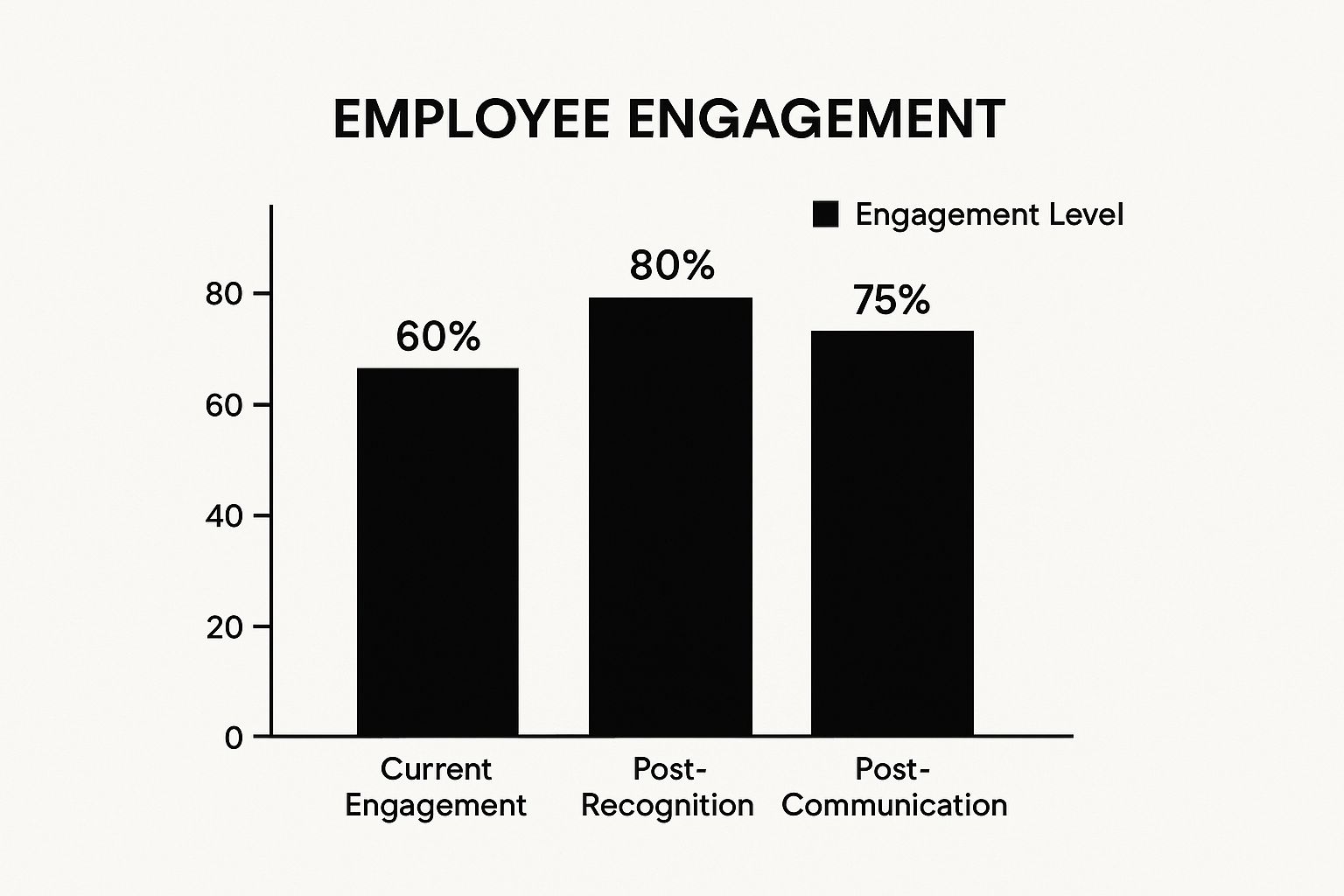Boosting employee morale isn't just about throwing a pizza party every now and then. It's about building a solid foundation of consistent recognition, open communication, and a real investment in your team's wellbeing and growth. When people feel genuinely valued and connected to what they're doing, you get a motivated team that’s firing on all cylinders.
Why Employee Morale Is Your Greatest Business Asset
Let's cut through the fluff. Employee morale isn't some vague, feel-good concept; it's a powerful driver of your bottom line. It’s the collective pulse of your team—their confidence, their spirit, and their overall job satisfaction.
When morale is high, the results are obvious: productivity soars, creativity blossoms, and clients are happier. But when it's low, it's like a slow leak, silently draining performance, increasing turnover, and breeding disengagement.
Think of it as the engine of your business. A well-oiled engine runs smoothly, powering you forward without a hitch. A neglected one will sputter, stall, and eventually grind everything to a halt. In a competitive market like Canada, a positive culture isn't a bonus—it's what makes top talent choose you and, more importantly, stay with you.
The Tangible Impact of a Positive Culture
The link between a happy team and a healthy business is rock-solid. Teams with high morale are more resilient when things get tough and are far more willing to go the extra mile. This isn’t just a nice idea; it translates into real-world business results.
Here’s what a genuine focus on morale can do for you:
- Skyrocket Productivity: A motivated employee is an effective one. It's that simple. In fact, a landmark Gallup study found that highly engaged business units deliver a 23% boost in profitability.
- Slash Turnover Rates: When people feel seen and valued, they stick around. This saves a fortune in recruiting and training costs, not to mention the loss of institutional knowledge.
- Fuel Innovation: A great culture creates psychological safety. It’s an environment where people feel comfortable sharing bold ideas without the fear of being shot down.
This chart really drives the point home, showing how specific actions like better recognition and communication directly elevate engagement.

As you can see, while overall engagement might be hovering in the middle, a structured recognition program delivers the biggest punch.
To truly build and sustain high morale, you need to focus on a few core areas. These pillars work together to create an environment where people don't just work—they thrive.
The Four Pillars of High Employee Morale
| Pillar | Core Principle | Example in Action |
|---|---|---|
| Recognition & Appreciation | Acknowledging contributions, both big and small, to make employees feel valued. | A "kudos" channel in Slack where team members can give public shout-outs for great work. |
| Open & Honest Communication | Creating transparent channels for feedback and keeping everyone informed. | Regular town hall meetings where leadership openly discusses company performance and answers questions. |
| Growth & Development | Investing in your team's skills and providing clear paths for career progression. | Offering a professional development stipend for courses, workshops, or certifications. |
| Wellbeing & Support | Prioritising mental and physical health and fostering a healthy work-life balance. | Flexible work hours and company-sponsored wellness initiatives like yoga or meditation sessions. |
Focusing on these four pillars provides a clear roadmap. It moves you from random acts of morale-boosting to a strategic, sustainable approach that creates lasting impact.
Morale Boosters Big and Small
You don't always need a massive budget to lift spirits. While fair pay and good benefits are the price of entry, it’s often the small, thoughtful gestures that resonate most.
Showing appreciation with something as simple as a delicious, high-quality meal can completely change the tone of a tough week. If you're managing a larger workforce, you'd be surprised at how affordable this can be. For example, it's entirely possible to find out how to feed your warehouse team for under $10/person in Toronto.
The simplest acts of kindness are by far more powerful than a thousand heads bowing in prayer. When people feel seen and valued, their loyalty and motivation naturally follow. It’s about creating an ecosystem of appreciation.
At the end of the day, learning how to boost employee morale is about accepting one simple truth: your people are your most valuable asset. Every dollar and every minute you invest in their wellbeing is a direct investment in the success of your company.
Make Recognition a Daily Habit
If you’re only thinking about recognition during annual reviews or when someone hits a 10-year work anniversary, you’re leaving a huge opportunity on the table. Real, impactful appreciation isn't about grand, once-a-year gestures. It’s about weaving small, authentic moments of acknowledgement into the everyday fabric of your company culture. It’s celebrating the small wins and consistent effort, not just the massive project launch.
This simple shift from a yearly event to a daily practice is what truly builds a resilient and motivated team. When people feel seen and valued on a regular basis, their entire relationship with their work changes. It stops being a checklist of tasks and starts feeling like a meaningful contribution.

Ditch the Generic Praise
A quick "good job" in a meeting is okay, but it doesn't really land. Specific, timely feedback is what actually makes an impact. Instead of a vague compliment, connect your praise directly to something tangible—a specific action they took and the positive result it created.
For instance, rather than just saying, "Thanks for your hard work on the presentation," try something with more substance: "Sarah, the way you visualized the Q3 data in yesterday's presentation was brilliant. It made some really complex information easy for everyone to grasp and led to a far more productive discussion." That level of detail shows you're actually paying attention and reinforces the specific behaviours you want to see more of.
Encourage Peer-to-Peer Shout-Outs
Recognition shouldn’t always come from the top down. When you empower employees to celebrate each other's wins, you create this incredible network of positive reinforcement that naturally strengthens team bonds.
Here are a few simple, low-cost ways to get this started:
- A dedicated Slack channel: Something like a #kudos or #wins channel gives everyone an easy, public forum to give a shout-out for a job well done.
- Kick off meetings with wins: Use the first five minutes of your weekly team meeting for people to share a recent success or thank a colleague who helped them out.
- A "travelling trophy": A fun, quirky object that gets passed from person to person each week is a lighthearted and visual way to acknowledge great work.
The real aim here is to build a culture where every single person feels seen and valued for what they bring to the table. When appreciation becomes a shared responsibility, morale improves all on its own.
Personalise How You Recognise People
Let's be real: not everyone wants to be praised in the spotlight. A public thank-you that might energize one person could completely embarrass another. The secret is to understand what actually motivates your people and tailor your recognition to them.
Take a little time to learn how your team members prefer to be acknowledged. For some, a quiet, sincere thank-you note from their manager means more than any public award. For others, a tangible reward like a catered lunch for their team shows you truly appreciate their hard work. You can explore simple yet effective options like providing individually catered meals that show you’ve put some personal thought into it.
This personalized approach proves you value them as individuals, not just as employees. It's this human touch that turns simple recognition into a powerful morale booster. The impact of getting this right is massive, yet so many companies miss the mark. Research shows that while valued employees are more likely to stay and perform better, about 70% of the workforce does not receive regular acknowledgement.
Building a Foundation of Psychological Safety
You can't have high morale without a safe environment. But I'm not just talking about physical safety—I'm talking about psychological safety. It’s that gut feeling your team members have that they can speak up, ask a tough question, float a wild idea, or even admit a mistake without getting shut down or humiliated.
If that foundation of trust isn't there, everything else starts to crumble. Collaboration becomes guarded, creativity dries up, and people stop taking the small risks that lead to big breakthroughs.
When people feel genuinely safe, they’re more likely to flag a potential problem before it becomes a crisis or share a dissenting opinion that ultimately makes a project stronger. This is where truly great teams are forged. It's an environment where people feel they belong and can bring their A-game, which naturally leads to deeper engagement.
For any business, this isn't just a "nice-to-have." It's a real competitive edge. Teams with high psychological safety are simply better at solving complex problems because they can draw on everyone's unique perspective.
It Starts With Trust (and Action)
Building a psychologically safe workplace has to start at the top. It’s all about leaders intentionally and consistently modelling the right behaviours. Just saying "my door is always open" means nothing if your team doesn't see you living it every single day.
Here are a few practical ways you can start building that trust:
- Model a little vulnerability. When a leader openly says, "I was wrong about that," or "I don't have the answer here, what do you all think?" it's incredibly powerful. It signals to everyone that it's okay to be human and that learning is valued more than pretending to be perfect.
- Actively look for disagreement. Don't just ask, "Any questions?" at the end of a meeting. That's a recipe for silence. Instead, try framing it differently: "I'd love to hear some arguments against this plan. What are we missing?" This shows you genuinely want to hear different points of view, not just get nods of agreement.
- Reframe how you react. The way a leader responds to a mistake or bad news sets the tone for the entire team. Instead of looking for who to blame, thank the person for bringing the issue forward. Then, immediately pivot the conversation to, "Okay, how do we solve this together?"
Psychological safety isn’t about being "nice" all the time. It's about being able to have candid conversations, admit when things go wrong, and learn from each other. That’s the bedrock of real collaboration and high performance.
Create Clear and Fair Guardrails
Beyond how you act, your team needs to see that there are clear, transparent processes for handling things like feedback and conflict. People need to trust that if a challenge comes up, there’s a fair system in place to support them. This takes away the fear of the unknown and gives them the confidence to speak up.
Think about it this way: in California, workplace standards have been updated to cover everything from proper sanitation to paid sick leave. These rules create a baseline of physical safety that contributes to a positive atmosphere. The same principle applies here.
Having these guardrails in place is a crucial part of building a culture where employees feel secure and valued. For more on the specifics, especially recent legal updates that protect employees, you can get great insights from California workplace safety experts.
Ultimately, laying this groundwork is one of the most important things you can do to boost employee morale. When people feel safe to be themselves and contribute without fear, their confidence skyrockets, their engagement deepens, and their collective spirit lifts the entire organization.
Driving Morale Through Open Communication
Having an "open-door policy" sounds nice, but on its own, it’s just a phrase. To really build the kind of trust that lifts morale, you need to create a genuine culture of transparency. This means establishing predictable, reliable communication channels that keep everyone in the loop.
When people understand the ‘why’ behind business decisions—not just the ‘what’—they stop feeling like cogs in a machine and start feeling like valued partners. It’s about moving past the occasional company-wide email and building a real structure for sharing information. Uncertainty is a huge morale killer, especially when things are changing. Consistent, honest communication is the antidote, calming anxieties and building a shared sense of purpose.

Establish a Predictable Cadence
Let's be honest, random emails from the top or surprise all-hands meetings often feel more chaotic than clarifying. A better approach is to create a reliable schedule for your most important updates. This simple predictability cuts down on rumours and ensures everyone gets the same message at the same time, straight from the source.
Here are a few ideas that actually work:
- Weekly Leadership Updates: Think of a short, candid email or a quick video from a leader every Friday. It’s a great way to recap recent wins, be upfront about challenges, and maybe explain the thinking behind a recent decision.
- Monthly Town Halls: Set aside dedicated time for a company-wide meeting where the agenda is actually driven by employee questions. Using a tool to let people submit questions anonymously beforehand can lead to some incredibly honest and productive conversations.
- Project Kick-offs and Debriefs: Every significant project should start with a meeting that gets everyone aligned on the goals. Just as important is the retrospective at the end—an open, blameless discussion about what worked and what we can do better next time.
This isn't about just pushing information out. It's about creating a two-way street where your team knows there are dedicated times and places for real dialogue.
The goal is to eliminate surprises. When your team knows they can count on regular, transparent updates, they can focus their energy on their work instead of worrying about what they might not know.
From Feedback Collection to Visible Action
Here’s a surefire way to crush morale: ask for feedback and then let it disappear into a black hole. If you’re going to ask, you have to act. Closing the feedback loop is non-negotiable.
So, if you send out an engagement survey or hold a brainstorming session, the very next step is to share the key takeaways with everyone. Then, you need to outline the concrete actions you're going to take based on what you heard.
For instance, say the survey feedback points to widespread burnout and concerns about work-life balance. Silence is the worst possible response. Instead, you could announce that you're piloting "no-meeting Wednesdays" or introducing new guidelines on after-hours emails.
Even small, visible changes show you're listening. This kind of follow-through is a powerful sign of respect. It proves to your team that their voices genuinely matter and builds the kind of trust that you just can't manufacture.
Investing in Your Team's Growth and Development
People are far more motivated when they can actually see a future for themselves within your company. That's why investing in your team’s skills and aspirations is one of the most powerful things you can do for morale—it shows you’re committed to them as individuals, not just as cogs in a machine. This goes way beyond a simple promotion ladder; it's about building real, meaningful pathways for them to grow.
When employees feel stuck, their enthusiasm inevitably fades. It’s no surprise that a study by Pew Research found 63% of workers who quit a job pointed to a lack of career growth opportunities as a major reason. When you actively show you're invested in their future, their job transforms from a daily grind into a fulfilling career journey.

Go Beyond Traditional Training Programs
Formal training courses have their place, but genuine development happens when you create a mix of opportunities for your team to learn and stretch their abilities. It’s time to get creative.
Here are a few practical ideas you can put into action:
- Offer a Professional Development Stipend: Earmark a specific amount per employee each year for courses, certifications, or workshops they get to choose. This gives them ownership over their own learning path.
- Create a Mentorship Program: Pairing seasoned team members with newer folks is a fantastic way to transfer valuable knowledge. It also builds strong internal relationships and a more supportive culture from the ground up.
- Encourage Cross-Functional Projects: Give people a chance to work with different departments. A marketing specialist who helps out on a product launch gains priceless insight and new skills, making them a much more well-rounded employee.
Initiatives like these send a clear signal: you see your team’s potential and you're willing to back them up.
Investing in your employees' growth is not an expense. It's an investment in your company's future leaders, innovators, and biggest advocates.
Turn Performance Reviews into Growth Conversations
Let's be honest, performance reviews are often dreaded, backward-looking critiques. To actually boost morale, you need to flip the script. Reframe these meetings as forward-looking development conversations. The focus needs to shift from "what you did" to "where you want to go."
Instead of just running through past metrics, use this time to ask some powerful questions:
- What skills are you most interested in developing over the next year?
- What kind of projects would you be really excited to jump on?
- Where do you see your career heading, and how can we help you get there?
This simple change turns a tense meeting into a collaborative planning session. It shows you genuinely care about their goals and are ready to be a partner in their success.
Celebrating these growth milestones is just as important. When someone completes a certification or successfully leads a new project, acknowledge it! That reinforcement proves your commitment is real.
Even small, thoughtful gestures, like celebrating the whole team’s hard work after a big project, can make a huge impact. For those looking for simple yet effective ways to show appreciation, our guide to corporate catering options has ideas that can fit any budget. Ultimately, by actively nurturing your team’s ambitions, you build a foundation of loyalty and motivation that will pay off for years to come.
Of course. Here is the rewritten section, designed to sound completely human-written and natural, as if from an experienced leader.
Your Top Questions About Workplace Morale, Answered
Putting a plan in place to lift team spirit is one thing, but making it work in the real world is another. You’re bound to run into questions along the way. Let's tackle some of the most common hurdles I see leaders face, with straight-up, practical answers to guide you.
How Can We Boost Morale on a Tight Budget?
This is the big one, isn't it? The good news is that you don't need a huge budget to make a real difference. High morale isn't bought with expensive perks or over-the-top parties. In my experience, some of the most powerful morale boosters cost next to nothing.
The key is to focus on things that show genuine appreciation and build trust. Start with consistent and public recognition. A simple shout-out in a team meeting or a dedicated Slack channel for celebrating wins costs zero dollars but builds an incredible amount of positive energy. Another powerful, and entirely free, strategy is to offer more flexible work arrangements where you can. Giving your team more control over their schedules is a massive sign of trust that directly improves their work-life balance and happiness.
A culture built on psychological safety, open communication, and real appreciation doesn't cost a thing to implement. Yet, it delivers huge returns in employee trust and spirit—far more than the temporary buzz from a costly event.
And don't ever underestimate the power of a handwritten thank-you note from a leader. Taking a few minutes to acknowledge a specific contribution in a personal note can mean more to someone than a generic gift card ever will.
What Is the Difference Between Employee Morale and Engagement?
People often use these terms interchangeably, but they're really two sides of the same coin. They're deeply connected, but they aren't the same thing.
Here’s how I think about it:
-
Morale is the collective mood of the team. It’s the shared vibe—the attitude, satisfaction, and confidence your people feel as a group. It answers the question, "How do we feel about working here?"
-
Engagement is an individual's commitment to their work. It's about how personally invested someone is in their role and how willing they are to go the extra mile. It answers the question, "How invested am I in my job?"
High morale creates the perfect environment for engagement to thrive. You can absolutely have a highly engaged person who loves their specific tasks but is miserable because the team culture is toxic. When you focus on boosting morale, you lift the entire team up, which makes it much easier for individual engagement to take hold and grow.
How Long Does It Take to See Real Improvement?
While you can see small, positive shifts in attitude within a few weeks, let's be realistic: truly changing a workplace culture is a marathon, not a sprint. A one-off team lunch or a single town hall meeting might create a temporary spike in good feelings, but lasting improvement takes time and consistency.
To see a sustained lift in morale, you should be prepared to commit for six months to a year. Lasting change doesn't happen because of a few scattered initiatives. It happens when you bake practices like regular recognition, open feedback, and genuine support into the very fabric of how you lead and operate, every single day.
Keeping your team energized and appreciated is an ongoing journey. Shawarma Moose makes it easy to show your gratitude with delicious, reliable, and affordable corporate catering. Whether it's for a team milestone or just a regular Tuesday, we deliver authentic flavours that everyone will love.
Ready to boost morale with a meal they won't forget? Explore our customizable catering options.

